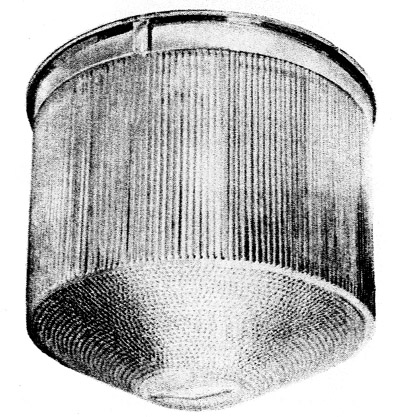 |

DIRECTIONAL STREET LIGHTING
LANTERNS FOR "OSIRA" LAMPS
BOWL REFRACTOR FOR G.E.C. "DI-FRACTOR"
AND "OXFORD" LANTERNS

Z 6007/9
G.E.C. GLASS BOWL REFRACTOR
British Patents No. 408419.
| Z 6607 | Bowl refractor, weight 5 lb. 11 oz., diameter 9in., depth 8in. | £1 14 8 |
| Z 6609 | Bowl refractor, weight 13 lb., diameter 11½in., depth 10in. | £2 12 8 |
|
SPECIFICATION
The bowl refractor illustrated above has been designed, developed and perfected at the G.E.C. Research Laboratories.
It embodies the G.E.C. patented principle of a concentrating refractor used in conjunction with a ribbed diffuser
combined in one single piece of accurately-made prismatic glassware of pleasing proportions. The main controlling
prisms, manufactured with extreme accuracy, redirect the light up and down the road in two main beams which,
being at 160° to each other, project the light slightly diagonally across the road. These prisms are moulded inside
the bowl and are, therefore, protected against dirt and dust, consequently they only required to be cleaned after long
intervals, thus reducign the cost of maintenance. On the outside of the bowl are moulded a series of shallow flutes and
prisms which give the correct amount of diffusion in the light in the main beams, thereby making the whole outside of
the bowl appear evenly flashed. Further, the light in the downward direction is controlled by a special diffusing
surface consisting of small graduated cones of carefully calculated angles, the effect of these being to distribute
more light immediately under the lantern, so preventing the occurrence of a dark patch normally present beneath
lanterns without this feature.
The result of the combination of these two optical systems is to produce continuous lanes of road brightness,
giving maximum silhouette and consequently long distance road visibility, and also to make the lantern bowl
appear evenly flashed, thereby eliminating glare. A less accurately designed refractor without these
diffusing prisms would be flashed over a small area only, and in consequence glare is produced. The external
diffusing flutes on the G.E.C. bowl refractor are very shallow and do not interfere in any way with the cleaning
of the glassware, and this also applies ot the somewhat deeper external prisms. In this connection,
it is interesting to note that even though the prisms on the outside of the bowl are easily cleaned and the flutes are
so shallow as to be self-cleaning, should dirt collect in the "VEE" formed by prisms the light distribution will
not be affected. This is due to the fact that rays of light emerge only from the tips of the prisms due to the
special optical system employed.
The glass from which the bowl is made is the result of very extensive research by the G.E.C. Laboratories, and besides having the required
optical properties it has the highly desirable feature that it will not fracture when subjected to rain splash when it is employed with
the recommended lamps. This is a most important consideration in view of the temperature which is produced inside the bowl. The locating device
moulded on the bowl refractor ensures correct alignment of the refractor in relation to the roadway and arrows indicating the direction of the
main beams can be seen on the underside of the bowl, so that it is a simple matter to ascertain that the bowl has been corrected fitted.
The manufacture of this bowl refractor is a great advance in pressed prismatic glassware and it is unique in that
its is the largest pressing made incorporating the internal refracting prisms with external diffusing flutes and prisms. This combination
results in the minimum of light absorption as the loss which occurs in two-piece refractors is avoided. In the latter type, as the result
of breathing every time the lamp is switched off, dust and dirt are deposited on the two inside surfaces and further absorption takes place due
to condensation.
When this bowl refractor unit is used in conjunction with OSRAM metal filament lamps certain modifications have to be made to the optical
system. The bowl refractor is designed for use witha thin vertical light source such as is produced by the OSIRA lamp, but, as the metal filament
lamp radiates its light in a horizontal plane, it is necessary to change the distribution from the horizontal to a vertical shape, and
this can be easily accomplished by the introduction of an inner symmetric dome refractor. This form of optical system is extremely efficient
for use with OSRAM gasfilled lamps when at the time only a D.C. supply system is available, and has the very great advantage that when the
supply is converted to A.C. the optical system can also be converted for use with OSIRA lamps, which can then be employed on the new supply.
The conversion is simply carried out by the removal of the inner dome refractor and the substitution of the vitreous enamelled reflector with
one of a suitable shape. This operation, which only occupies a few minutes, can be done with the lantern in-situ and without any alteration to
the wiring.
Back to: GEC Street Lighting
|



